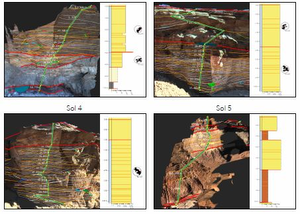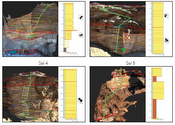Information
- Publication Type: Journal Paper with Conference Talk
- Workgroup(s)/Project(s):
- Date: November 2020
- Journal: IEEE Transactions on Visualization and Computer Graphics
- Volume: 21
- Open Access: yes
- Lecturer: Thomas Ortner
- Event: VAST 2020: IEEE Symposium on Visual Analytics Science and Technology
- DOI: 10.1109/TVCG.2020.3030409
- Call for Papers: Call for Paper
- Conference date: October 2020
- Pages: 1 – 10
Abstract
Geological analysis of 3D Digital Outcrop Models (DOMs) for reconstruction of ancient habitable environments is a key aspect of the upcoming ESA ExoMars 2022 Rosalind Franklin Rover and the NASA 2020 Rover Perseverance missions in seeking signs of past life on Mars. Geologists measure and interpret 3D DOMs, create sedimentary logs and combine them in ‘correlation panels’ to map the extents of key geological horizons, and build a stratigraphic model to understand their position in the ancient landscape. Currently, the creation of correlation panels is completely manual and therefore time-consuming, and inflexible. With InCorr we present a visualization solution that encompasses a 3D logging tool and an interactive data-driven correlation panel that evolves with the stratigraphic analysis. For the creation of InCorr we closely cooperated with leading planetary geologists in the form of a design study. We verify our results by recreating an existing correlation analysis with InCorr and validate our correlation panel against a manually created illustration. Further, we conducted a user-study with a wider circle of geologists. Our evaluation shows that InCorr efficiently supports the domain experts in tackling their research questions and that it has the potential to significantly impact how geologists work with digital outcrop representations in general.Additional Files and Images
Weblinks
BibTeX
@article{Ortner2020,
title = "InCorr: Interactive Data-Driven Correlation Panels for
Digital Outcrop Analysis",
author = "Thomas Ortner and Andreas Walch and Rebecca Nowak and Robert
Barnes and Thomas H\"{o}llt and Eduard Gr\"{o}ller",
year = "2020",
abstract = "Geological analysis of 3D Digital Outcrop Models (DOMs) for
reconstruction of ancient habitable environments is a key
aspect of the upcoming ESA ExoMars 2022 Rosalind Franklin
Rover and the NASA 2020 Rover Perseverance missions in
seeking signs of past life on Mars. Geologists measure and
interpret 3D DOMs, create sedimentary logs and combine them
in ‘correlation panels’ to map the extents of key
geological horizons, and build a stratigraphic model to
understand their position in the ancient landscape.
Currently, the creation of correlation panels is completely
manual and therefore time-consuming, and inflexible. With
InCorr we present a visualization solution that encompasses
a 3D logging tool and an interactive data-driven correlation
panel that evolves with the stratigraphic analysis. For the
creation of InCorr we closely cooperated with leading
planetary geologists in the form of a design study. We
verify our results by recreating an existing correlation
analysis with InCorr and validate our correlation panel
against a manually created illustration. Further, we
conducted a user-study with a wider circle of geologists.
Our evaluation shows that InCorr efficiently supports the
domain experts in tackling their research questions and that
it has the potential to significantly impact how geologists
work with digital outcrop representations in general.",
month = nov,
journal = "IEEE Transactions on Visualization and Computer Graphics",
volume = "21",
doi = "10.1109/TVCG.2020.3030409",
pages = "1--10",
URL = "https://www.cg.tuwien.ac.at/research/publications/2020/Ortner2020/",
}


 Image
Image Paper
Paper
